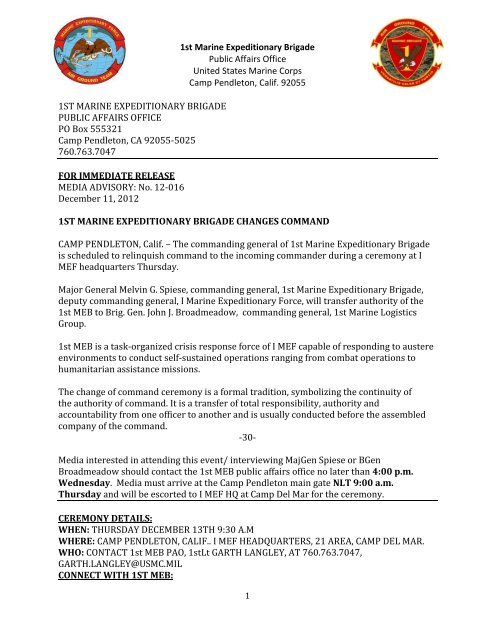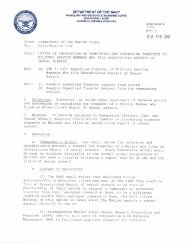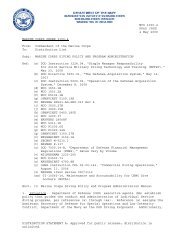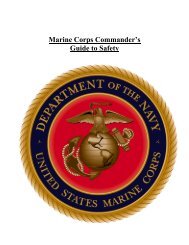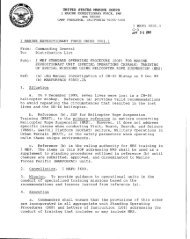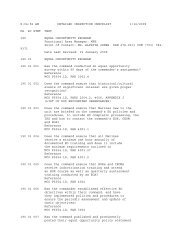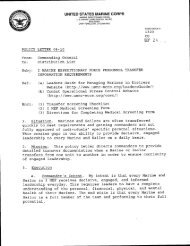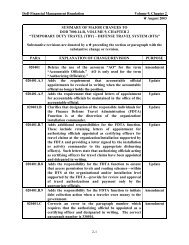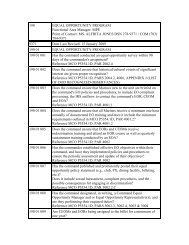12-016 1st meb change of command release - I Marine ...
12-016 1st meb change of command release - I Marine ...
12-016 1st meb change of command release - I Marine ...
You also want an ePaper? Increase the reach of your titles
YUMPU automatically turns print PDFs into web optimized ePapers that Google loves.
1ST MARINE EXPEDITIONARY BRIGADEPUBLIC AFFAIRS OFFICEPO Box 555321Camp Pendleton, CA 92055-5025760.763.7047FOR IMMEDIATE RELEASEMEDIA ADVISORY: No. <strong>12</strong>-<strong>016</strong>December 11, 20<strong>12</strong><strong>1st</strong> <strong>Marine</strong> Expeditionary BrigadePublic Affairs OfficeUnited States <strong>Marine</strong> CorpsCamp Pendleton, Calif. 920551ST MARINE EXPEDITIONARY BRIGADE CHANGES COMMANDCAMP PENDLETON, Calif. – The <strong>command</strong>ing general <strong>of</strong> <strong>1st</strong> <strong>Marine</strong> Expeditionary Brigadeis scheduled to relinquish <strong>command</strong> to the incoming <strong>command</strong>er during a ceremony at IMEF headquarters Thursday.Major General Melvin G. Spiese, <strong>command</strong>ing general, <strong>1st</strong> <strong>Marine</strong> Expeditionary Brigade,deputy <strong>command</strong>ing general, I <strong>Marine</strong> Expeditionary Force, will transfer authority <strong>of</strong> the<strong>1st</strong> MEB to Brig. Gen. John J. Broadmeadow, <strong>command</strong>ing general, <strong>1st</strong> <strong>Marine</strong> LogisticsGroup.<strong>1st</strong> MEB is a task-organized crisis response force <strong>of</strong> I MEF capable <strong>of</strong> responding to austereenvironments to conduct self-sustained operations ranging from combat operations tohumanitarian assistance missions.The <strong>change</strong> <strong>of</strong> <strong>command</strong> ceremony is a formal tradition, symbolizing the continuity <strong>of</strong>the authority <strong>of</strong> <strong>command</strong>. It is a transfer <strong>of</strong> total responsibility, authority andaccountability from one <strong>of</strong>ficer to another and is usually conducted before the assembledcompany <strong>of</strong> the <strong>command</strong>.-30-Media interested in attending this event/ interviewing MajGen Spiese or BGenBroadmeadow should contact the <strong>1st</strong> MEB public affairs <strong>of</strong>fice no later than 4:00 p.m.Wednesday. Media must arrive at the Camp Pendleton main gate NLT 9:00 a.m.Thursday and will be escorted to I MEF HQ at Camp Del Mar for the ceremony.CEREMONY DETAILS:WHEN: THURSDAY DECEMBER 13TH 9:30 A.MWHERE: CAMP PENDLETON, CALIF.. I MEF HEADQUARTERS, 21 AREA, CAMP DEL MAR.WHO: CONTACT <strong>1st</strong> MEB PAO, <strong>1st</strong>Lt GARTH LANGLEY, AT 760.763.7047,GARTH.LANGLEY@USMC.MILCONNECT WITH 1ST MEB:1
<strong>1st</strong> <strong>Marine</strong> Expeditionary BrigadePublic Affairs OfficeUnited States <strong>Marine</strong> CorpsCamp Pendleton, Calif. 92055ON THE WEB www.imef.marines.mil/Units/1STMEBDOWNLOAD HD PHOTOS, VIDEOSQ’s/ A’s1. When was 1 st MEB re-activated?a. October 2 nd 20092. What did 1 st MEB do after activation?a. After the 2009 activation, <strong>Marine</strong>s and sailors <strong>of</strong> the <strong>1st</strong> MEB executed a <strong>12</strong>-month deployment in the spring <strong>of</strong> 2010 in support <strong>of</strong> Operation EnduringFreedom in Afghanistan conducting counterinsurgency operations andtraining Afghan national security forces. The unit joined NATO'sInternational Security Assistance Force in Afghanistan's Regional Command-South.3. What are MEB’s designed to do?a. The nation depends on the <strong>Marine</strong> Corps to deploy forces with the ability tomove ashore and self-sustain for prolonged operations. These forces areorganized into various <strong>Marine</strong> Air Ground Task Forces, or MAGTFs, whichcombine aviation, ground and support assets under one <strong>command</strong>er.Depending on the situation – whether it’s combat operations, crisis responseor humanitarian assistance – a MAGTF will morph, in size and capability, tomeet the requirement.b. MEB’s provide unique and agile force projection capabilities that are greatlyenhanced when partnered with naval forces, from assaulting an enemybeachhead to bringing ashore food and supplies to a disaster-stricken nation4. What does <strong>1st</strong> MEB provide to I MEF?a. A <strong>Marine</strong> Expeditionary Brigade comprises a <strong>Marine</strong> Air-Ground Task Forceconstructed around a <strong>command</strong> element, a ground combat element, anaviation combat element and a logistics combat element. The <strong>1st</strong> MEB willinclude a reinforced infantry regiment, a composite <strong>Marine</strong> aircraft group,and a brigade logistics support group.5. How many <strong>Marine</strong>s make up a MEB?a. Before the re-establishment <strong>of</strong> the MEB which can range from 4,000 to16,000 <strong>Marine</strong>s, the <strong>Marine</strong> Expeditionary Unit with around 2,200 <strong>Marine</strong>s,and the <strong>Marine</strong> Expeditionary Force with 50,000.6. What training has <strong>1st</strong> MEB conducted?2
<strong>1st</strong> <strong>Marine</strong> Expeditionary BrigadePublic Affairs OfficeUnited States <strong>Marine</strong> CorpsCamp Pendleton, Calif. 92055Major General Melvin G. SpieseDeputy Commanding General, I <strong>Marine</strong> Expeditionary Force; and CommandingGeneral, <strong>1st</strong> <strong>Marine</strong> Expeditionary BrigadeMajor General Spiese was commissioned via the NROTCprogram after receiving a Bachelor <strong>of</strong> Science degree in CivilEngineering from the University <strong>of</strong> Illinois, Urbana-Champaign in May <strong>of</strong> 1976.After The Basic School, Major General Spiese was assignedto 3d Battalion, 4th <strong>Marine</strong>s as a Rifle Platoon Commander,Executive Officer and Commanding Officer with Company L,and served on the battalion staff. Upon return to CONUS,Major General Spiese was assigned to <strong>Marine</strong> Barracks,Naval Weapons Station, Concord, CA. In May <strong>of</strong> 1981 he wasassigned to 3d Battalion, 9th <strong>Marine</strong>s as the CommandingOfficer <strong>of</strong> Company I and Battalion S-4. In May 1983 he wastransferred to the NROTC Unit, Illinois Institute <strong>of</strong>Technology as the <strong>Marine</strong> Officer Instructor.Leaving Illinois in June 1986, Major General Spiese was posted to Headquarters <strong>Marine</strong>Corps, serving as the Head <strong>of</strong> Regular Officer Procurement. Following his tour atHeadquarters, he attended <strong>Marine</strong> Corps Command and Staff College, graduating in May <strong>of</strong>1990. After graduation, Major General Spiese was transferred to <strong>Marine</strong> Corps Air Stationin Iwakuni, Japan and was assigned to <strong>Marine</strong> Aircraft Group <strong>12</strong> as the Assistant OperationsOfficer and Ground Combat Liaison.Major General Spiese was assigned to 6th <strong>Marine</strong>s in July <strong>of</strong> 1991 as the Executive Officer <strong>of</strong>3d Battalion, then Regiment S-3. He assumed <strong>command</strong> <strong>of</strong> 2d Force ReconnaissanceCompany in December 1993. Upon relinquishing <strong>command</strong> in July 1995, Major GeneralSpiese was reassigned to U.S. Special Operations Command, serving as a Policy Officerdealing with Counter Proliferation <strong>of</strong> Weapons <strong>of</strong> Mass Destruction and <strong>Marine</strong> Corpsmatters. Upon his departure from USSOCOM, Major General Spiese attended Top LevelSchool at the U.S. Army School <strong>of</strong> Advanced Military Studies as a Fellow in the AdvancedOperational Arts Studies program. He remained a second year serving as a seminar leaderfor the Advanced Military Studies Program, a second year program for majors attending theArmy Command and General Staff College.Major General Spiese was assigned to the <strong>Marine</strong> Corps Air Ground Combat Center in June<strong>of</strong> 1999 as the Director, Tactical Training Exercise Control Group. He assumed <strong>command</strong> <strong>of</strong>the School <strong>of</strong> Infantry (East) in June <strong>of</strong> 2001, and was assigned as the Director,4
<strong>1st</strong> <strong>Marine</strong> Expeditionary BrigadePublic Affairs OfficeUnited States <strong>Marine</strong> CorpsCamp Pendleton, Calif. 92055insurgency operations in Al Anbar, Iraq for OIF II; and AC/S G-4, 3rd <strong>Marine</strong> Aircraft Wing.His <strong>command</strong> billets include Commanding Officer, <strong>Marine</strong> Wing Support Squadron 371deploying to Al Anbar, Iraq for OIF 04-06; Commanding Officer, Combat Logistics Regiment17; and Team Chief and Senior Advisor to the 7th Iraqi Infantry Division in Iraq for OIF–08.As a General Officer he was assigned as the Deputy Commanding General, <strong>Marine</strong> ForcesPacific in August 2009. During this tour he also served as the Combined Force LandComponent Commander (CFLCC) for Exercise Rim <strong>of</strong> the Pacific '10 and as the DeputyCommander for Joint Task Force 505 in Japan for Operations Tomodachi and PacificPassage. Brigadier General Broadmeadow assumed Command <strong>of</strong> <strong>1st</strong> <strong>Marine</strong> LogisticsGroup in June 2011 and deployed to Afghanistan in Feb 20<strong>12</strong> for OEF <strong>12</strong>.Brigadier General Broadmeadow is a graduate <strong>of</strong> the USMC Amphibious Warfare Schooland Command and Staff College (non resident programs), a graduate <strong>of</strong> the U.S. Army WarCollege in 2001, the Joint Forces Staff College in 2008, and the National DefenseUniversity’s CAPSTONE Course in 2009. He holds a B.S. in Business Administration fromNorwich University, a dual M.A. in Business Administration and Computer ResourcesManagement from Webster University, and a M.S. in Strategic Studies from the U.S. ArmyWar College.- END-6


